
How to Use 18650 Lithium Battery Boost Module Type-C: Examples, Pinouts, and Specs
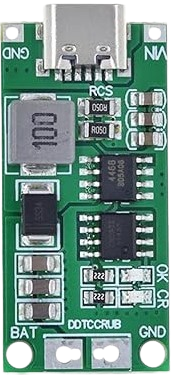
 Design with 18650 Lithium Battery Boost Module Type-C in Cirkit Designer
Design with 18650 Lithium Battery Boost Module Type-C in Cirkit DesignerIntroduction
The 18650 Lithium Battery Boost Module Type-C (Manufacturer Part ID: H-1-1790-2S1A) by Hailege is a compact and efficient power module designed to boost the voltage from a single 18650 lithium battery. It features a Type-C input for charging and power delivery, making it ideal for powering a wide range of electronic devices. This module is particularly useful in portable electronics, DIY projects, and battery-powered systems where a stable output voltage is required.
Explore Projects Built with 18650 Lithium Battery Boost Module Type-C
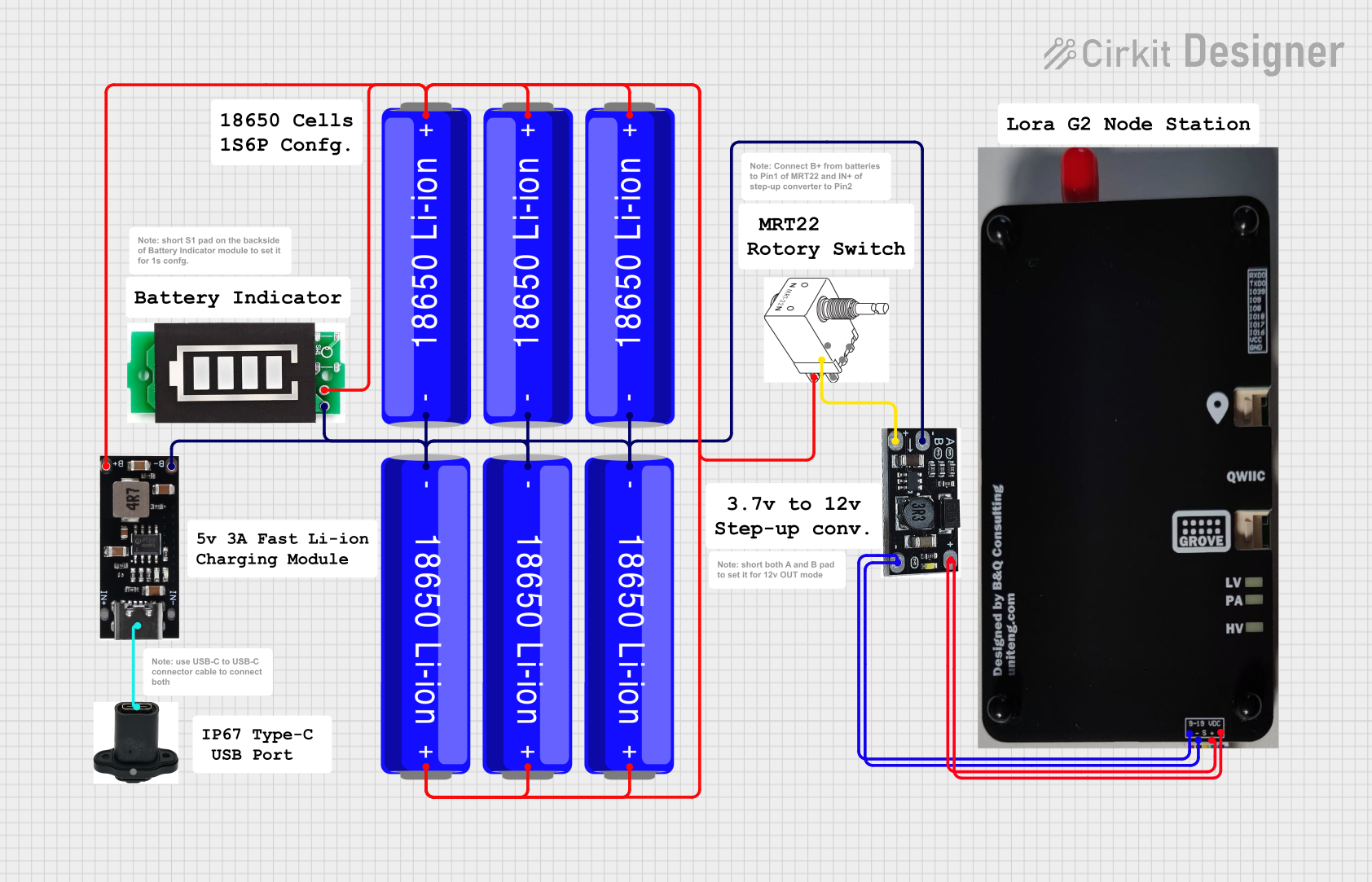
 Open Project in Cirkit Designer
Open Project in Cirkit Designer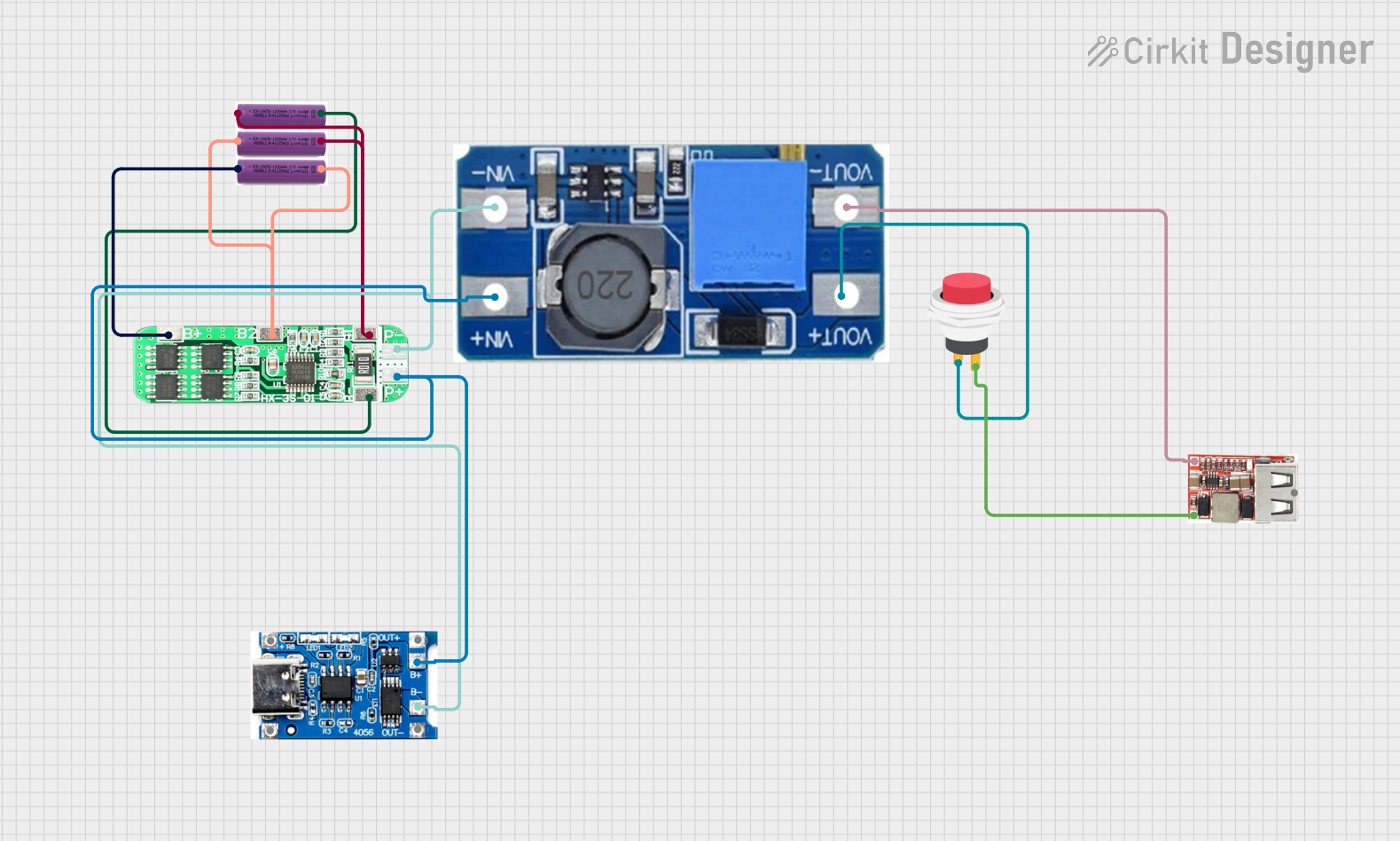
 Open Project in Cirkit Designer
Open Project in Cirkit Designer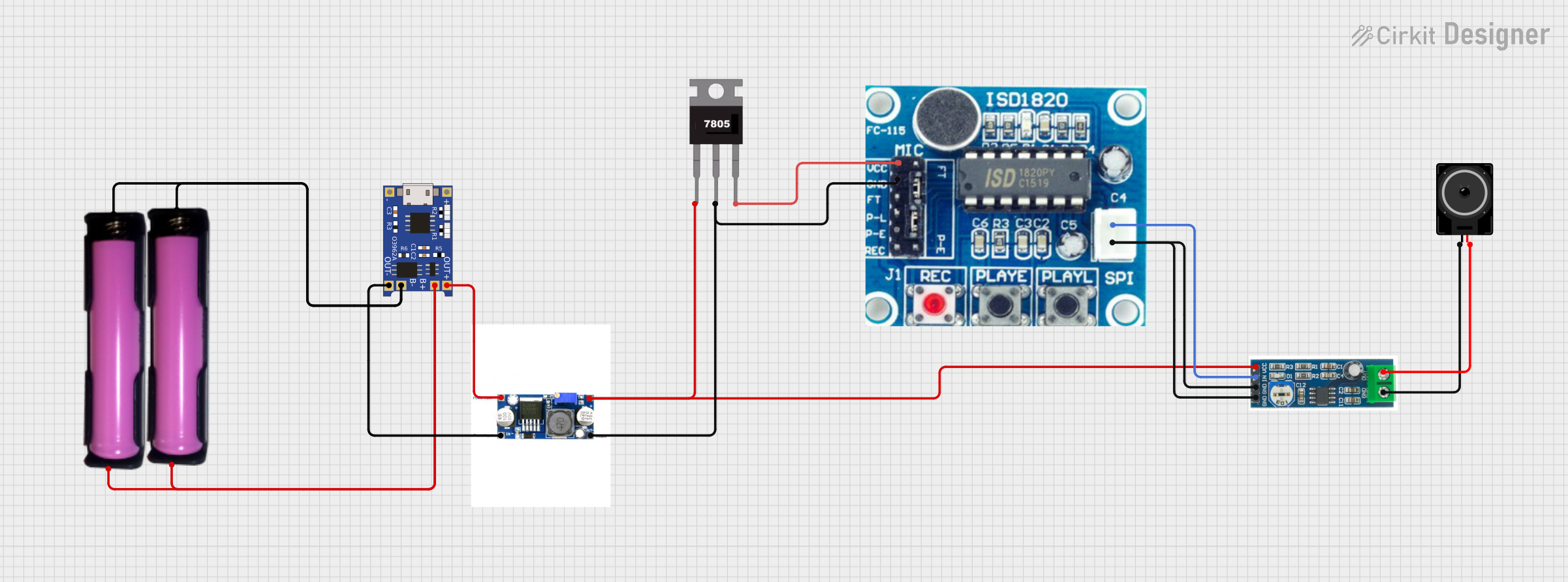
 Open Project in Cirkit Designer
Open Project in Cirkit Designer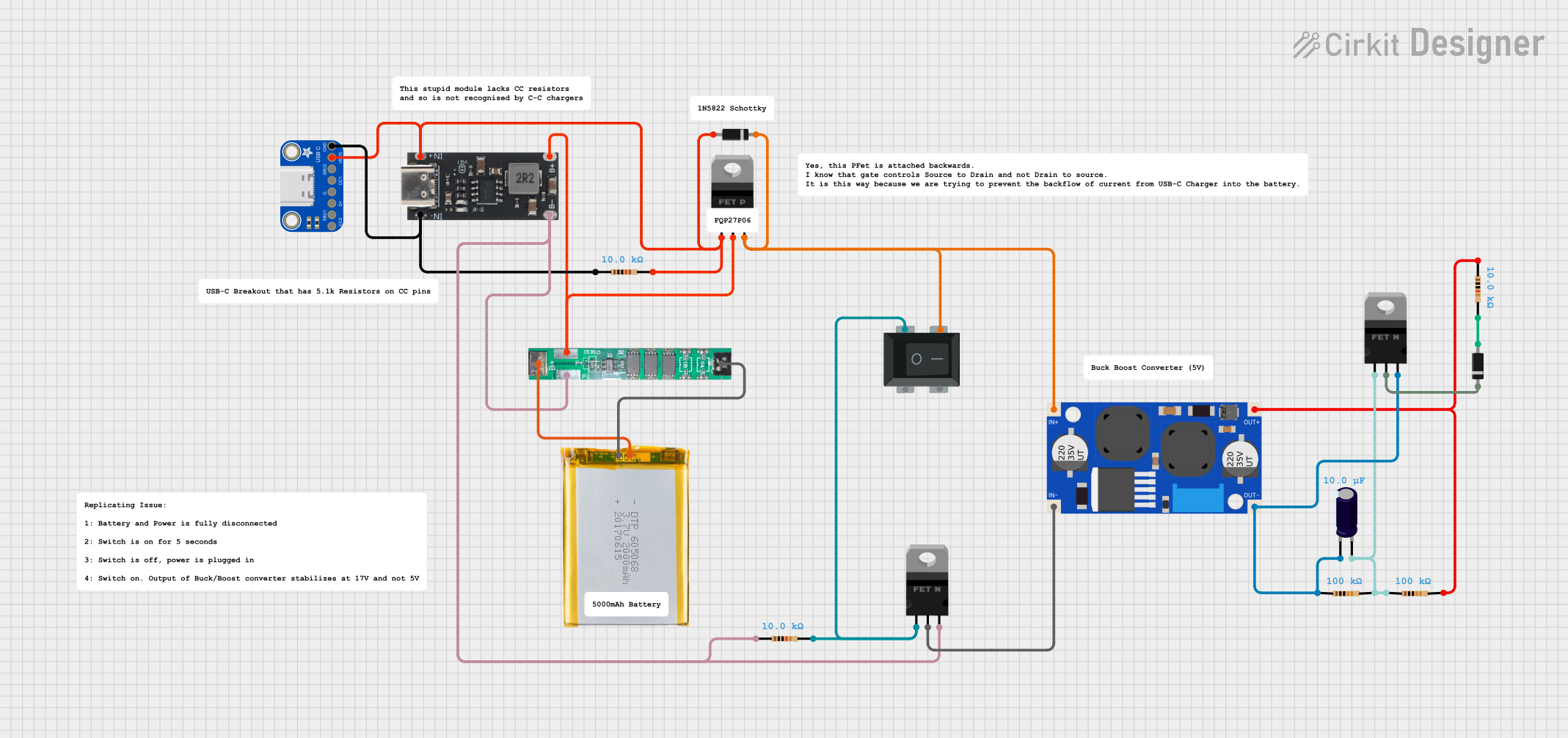
 Open Project in Cirkit Designer
Open Project in Cirkit DesignerExplore Projects Built with 18650 Lithium Battery Boost Module Type-C

 Open Project in Cirkit Designer
Open Project in Cirkit Designer
 Open Project in Cirkit Designer
Open Project in Cirkit Designer
 Open Project in Cirkit Designer
Open Project in Cirkit Designer
 Open Project in Cirkit Designer
Open Project in Cirkit DesignerCommon Applications and Use Cases
- Powering microcontrollers (e.g., Arduino, ESP32, Raspberry Pi Pico)
- Portable USB-powered devices
- DIY power banks
- Emergency backup power supplies
- Robotics and IoT projects
Technical Specifications
Below are the key technical details of the 18650 Lithium Battery Boost Module Type-C:
| Parameter | Specification |
|---|---|
| Input Voltage Range | 3.0V - 4.2V (Single 18650 Battery) |
| Output Voltage | 5V (Boosted) |
| Output Current | Up to 1A |
| Charging Input Port | Type-C |
| Charging Input Voltage | 5V |
| Charging Current | 1A |
| Efficiency | Up to 92% |
| Dimensions | 25mm x 15mm x 5mm |
| Protection Features | Overcharge, Overdischarge, Short Circuit |
Pin Configuration and Descriptions
The module has the following key pins and connectors:
| Pin/Connector | Description |
|---|---|
BAT+ |
Positive terminal for the 18650 battery. |
BAT- |
Negative terminal for the 18650 battery. |
OUT+ |
Positive output terminal for the boosted 5V voltage. |
OUT- |
Negative output terminal for the boosted 5V voltage. |
Type-C Port |
Input port for charging the 18650 battery using a 5V Type-C power source. |
Usage Instructions
How to Use the Component in a Circuit
- Connect the Battery:
- Attach the positive terminal of the 18650 battery to the
BAT+pin. - Attach the negative terminal of the 18650 battery to the
BAT-pin.
- Attach the positive terminal of the 18650 battery to the
- Connect the Load:
- Connect the device or circuit requiring 5V power to the
OUT+andOUT-pins.
- Connect the device or circuit requiring 5V power to the
- Charging the Battery:
- Use a Type-C cable to connect a 5V power source to the module's Type-C port. The module will charge the 18650 battery while simultaneously providing power to the load.
- Verify Connections:
- Ensure all connections are secure and polarity is correct to avoid damage to the module or connected devices.
Important Considerations and Best Practices
- Battery Selection: Use a high-quality 18650 lithium battery with a capacity of at least 2000mAh for optimal performance.
- Heat Management: Avoid overloading the module beyond its 1A output current limit to prevent overheating.
- Polarity Protection: Double-check the polarity of the battery and load connections to avoid damage.
- Charging Safety: Do not leave the module unattended while charging the battery to prevent overcharging or overheating.
Example: Using with Arduino UNO
The module can be used to power an Arduino UNO via its 5V pin. Below is an example setup:
- Connect the
OUT+pin of the module to the 5V pin of the Arduino UNO. - Connect the
OUT-pin of the module to the GND pin of the Arduino UNO. - Insert a charged 18650 battery into the module and ensure proper polarity.
Here is a simple Arduino sketch to blink an LED while powered by the module:
// Blink an LED connected to pin 13 of the Arduino UNO
void setup() {
pinMode(13, OUTPUT); // Set pin 13 as an output
}
void loop() {
digitalWrite(13, HIGH); // Turn the LED on
delay(1000); // Wait for 1 second
digitalWrite(13, LOW); // Turn the LED off
delay(1000); // Wait for 1 second
}
Troubleshooting and FAQs
Common Issues and Solutions
Module Not Powering the Load:
- Cause: Battery voltage is too low.
- Solution: Recharge the 18650 battery using the Type-C port.
Overheating During Operation:
- Cause: Load exceeds the 1A output current limit.
- Solution: Reduce the load current or use a more efficient device.
Battery Not Charging:
- Cause: Faulty Type-C cable or insufficient input voltage.
- Solution: Use a high-quality Type-C cable and ensure the input voltage is 5V.
No Output Voltage:
- Cause: Incorrect battery polarity or loose connections.
- Solution: Verify the battery polarity and ensure all connections are secure.
FAQs
Q1: Can I use this module with other lithium battery types?
A1: This module is specifically designed for 18650 lithium batteries. Using other battery types may result in improper operation or damage.
Q2: What happens if I connect a load that requires more than 1A?
A2: The module may overheat or shut down to protect itself. Always ensure the load current is within the 1A limit.
Q3: Can I use the module without a battery?
A3: No, the module requires a connected 18650 battery to function properly.
Q4: Is the module safe to use for long-term applications?
A4: Yes, the module includes protection features such as overcharge, overdischarge, and short circuit protection, making it safe for long-term use when used within its specifications.